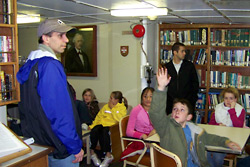I was feeling downright nostalgic as Dr. Bob and I showed the enthusiastic Morse Pond students and their teachers around Knorr on a rainy day during Thanksgiving week. During our month at sea, we had come to think of her as ours, but of course she wasn’t. And now she didn’t even look like the same ship, her decks and labs filled with containers and heavy, obscure machinery to accomplish her next mission. (May she always have a next mission.) She was leaving Woods Hole at 0900 the next day bound for the Panama Canal, thence into the vast Pacific to extract sediment samples from the bottom. It’s called “long coring,” and its purpose is to learn, from the fossil deposits in the bottom sediments, something about the condition of the climate in the deep past, called “paleoclimatology” and what the past might reveal about our present climate. (At this writing, she has transited the canal, the new science staff has come aboard, and she has set out into the Pacific Ocean.) Earlier that day, I had visited Morse Pond School to talk about our Denmark Strait/Irminger Sea trip and about daily life aboard Knorr in hard weather. To demonstrate safety procedures, Ms. Keoughan, despite a touch of claustrophobia, donned an immersion suit, a “Gumby” suit, to everyone’s delight. Asked how many would like to go to sea someday on a research vessel, all the Morse Pond students raised their hands. I share their wishes. Over lunch, after the ship tours, Dr. Bob and I chatted about the need and means for active communication between ocean scientists—all Earth scientists, for that matter—and the public, which includes you and your parents. Our Knorr cruise, her present Pacific cruise, and many more to come are, as we’ve said before, funded by the Nation Science Foundation (NSF), which in turn is funded by taxpayer dollars. The NSF is keenly interested in informing us as to how our money is spent, but, as everyone recognizes, it’s about more than money. Scientists are interested in explaining their work to the rest of us; you can tell by their enthusiasm in response to our expression of interest. But what about the rest of us? Are we interested in hearing? It’s tricky business, this “outreach.” Like any sort of communication, it must work both ways if it’s to succeed. Say, twenty years ago scientists could go about their business trying to understand how our Earth works, how nature works in their own highly specialized fields using specialized tools, and talking only with their colleagues. Meanwhile, we could follow our own busy walks of life not really needing to know what the wiggy scientists were taking about in their thorny, exclusive lingo. Scientists didn’t have much incentive to talk to us, and we lacked incentive to listen. We hope that is about to change. The world has certainly changed under us during the last two decades. Every day we displace more and more of the natural world to make space for ourselves and for our works. Now we’ve learned—from scientists—or we should have, that our way of life is changing our climate. What was hospitable to my generation may be inhospitable to yours. Humans have become so powerful that we’ve already inherited a new relationship to nature, as its custodians. (As you grow up, you’ll be hearing a lot about sustainability.) Only scientists can tell us true things about the way our world works. I know we’ve said this in earlier dispatches, but it’s worth repeating: Now we must learn to listen to scientists; equally, they must practice communicating with us. As you’ve probably already noticed, it’s not easy to learn new things. But it’s soon going to be your world that Dr. Bob and his colleagues are trying now to understand. For now, I wish you all the best with it. Later maybe our courses will cross again aboard Knorr. Dr. Bob will be returning to Greenland waters. I, for one, will be aboard, I hope. We both hope you’ll come along. Last updated: December 8, 2008 | |||||||||||||||||||
Copyright ©2007 Woods Hole Oceanographic Institution, All Rights Reserved, Privacy Policy. | |||||||||||||||||||

